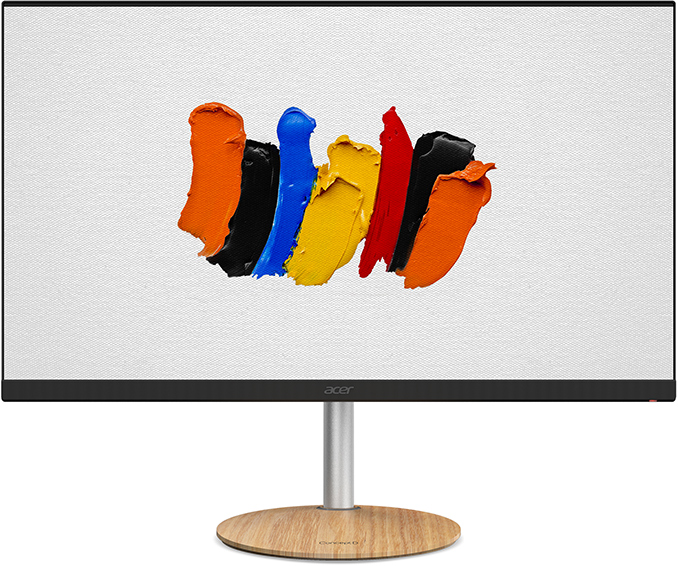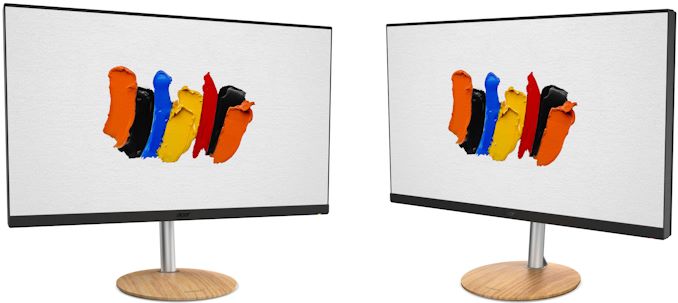Acer Joins Mini LED Monitor Club with Professional-Focused ConceptD CM7321K
by Anton Shilov on April 19, 2019 4:45 PM EST
As the era of Mini LED backlighting takes off in earnest, Acer has become another major supplier of displays to announce a monitor incorporating the tech. The ConceptD CM7321K is a high-end PC monitor that will be aimed at graphics and video professionals who need a wide color gamut, a high contrast ratio, a very high luminance, and a Delta E<1 color accuracy.
Acer's ConceptD CM7321K monitor uses a 10-bit 31.5-inch IPS panel featuring a 3840×2160 resolution, 600 - 1000-nits brightness (typical and peak in HDR mode), a 4 ms response time, a 60 Hz refresh rate, and 178°/178° horizontal/vertical viewing angles. The key feature of this display is its backlighting, with 1152 Mini LED zones for dynamic local dimming.
Backlighting based on hundreds (or thousands) of independently-controlled Mini LEDs promises to bring capabilities of LCDs closer to those of OLEDs when it comes to contrast ratio, color gamut, and brightness. Leading panel suppliers demonstrated prototypes of products outfitted with this kind of backlighting last year, with plans on the TV side of matters to start commercial shipments of Mini LED Ultra-HD televisions in 2019. As it appears, Acer and ASUS will be ready with their PC displays featuring this innovative backlighting this year as well.
In case of the ConceptD CM7321K monitor, thanks to its Mini LED-based full area local dimming (FALD) backlighting with 1152 zones, Acer is rating its contrast ratio as 100,000,000:1 when adaptive contrast management (ACM) is in use, Though it goes without saying that like other adaptive contrast setups, Acer's ACM contrast ratio should not be compared head-to-head to 'usual' contrast ratio reported by manufacturers. Meanwhile the wide spectrum of the backlight means that the display can cover 99% of the AdobeRGB and 89.5% of the Rec.2020 color gamuts.
To ensure that professionals get a good experience out of the box, Acer has validated its ConceptD CM7321K with Pantone color institute, and will ship the monitor pre-calibrated to a Delta E<1 color accuracy (presumably for all color gamuts it will support). The display also carries VESA's DisplayHDR 1000 badge, so it meets the VESA's highest standards for a HDR monitor, and this means it will support at least HDR10 (no word on Dolby Vision, though).
As far as connectivity is concerned, the monitor has two Thunderbolt 3 connectors (one input and one output to daisy chain two LCDs), four HDMI 2.0b inputs, as well as one DisplayPort 1.2. In addition, the display has two 3 Watt speakers.
| Brief Specifications of the Acer ConceptD CM7321K | ||
| Panel | 31.5" IPS | |
| Resolution | 3840 × 2160 | |
| Refresh Rate | 60 Hz | |
| Response Time | 4 ms gray-to-gray | |
| Brightness | Normal: 600 cd/m² HDR mode: 1000 cd/m² |
|
| Contrast | 100,000,000:1 (ACM) |
|
| Viewing Angles | 178°/178° horizontal/vertical | |
| Color Saturation | 99% Adobe RGB 89.5% Rec. 2020 ? DCI-P3 |
|
| Display Colors | 1.07 billion | |
| 3D-LUT | ? bits | |
| Pixel Pitch | 0.1816 mm² | |
| Pixel Density | 140 PPI | |
| Anti-Glare Coating | ? | |
| Inputs | 1 × DP 1.2 4 × HDMI 2.0b 1 × Thunderbolt 3 (one output) |
|
| USB Hub | ? | |
| Audio | 2 × 3 W speakers 3.5-mm mini jack (?) |
|
| Mechanical Design | Chassis Colors: black, metallic. wood Tilt: yes Height Adjustment: yes Swivel: yes |
|
| Power Consumption | Idle | ? |
| Active | ? | |
Finally, the high-end display will be hitting the streets in September, and with a price tag to match: Acer will be selling the monitor for $2,999/€3,199 (MSRP). Given the cutting-edge nature of Mini LED backlighting, this is not particularly surprising, as they'll make up a significant portion of the build costs on all of these first-generation Mini LED monitors.
Related Reading:
- ASUS Shows Off Dolby Vision Monitors: The ProArt PQ22UC & ProArt PA32UCX
- The New Acer ConceptD Family: Workstations and Displays for Professionals
- ASUS at CES 2019: ProArt PA32UCX 4K Monitor with 1000-Zone FALD Unveiled
- Acer Unveils ProDesigner BM270 LCD with Delta E<1 Color Accuracy: 4K, HDR, FALD
Source: Acer











30 Comments
View All Comments
FreckledTrout - Monday, April 22, 2019 - link
Neither do like 99% of the gamers either. Going from 120Hz to 60Hz reduces the input lag from the refresh rate from 16.67ms to 8.33ms. Virtually nobody is going to really be impacted by 8ms change in responsiveness. Some people might notice very fast moving artifacts but if the monitor is really good at overdrive it wont matter either.FreckledTrout - Monday, April 22, 2019 - link
Going from 60Hz to 120Hz....No edit.Beaver M. - Monday, April 22, 2019 - link
You clearly have no idea what youre even talking about, like most here.Input lag has little to do with the refresh rate.
An input lag of 16 ms would be far too much already. 8 ms would still be a lot. Good panels have lower than 2 ms, some even lower than 1 ms.
Refresh rate impacts the response time. Motion blur. I dont know how you work, but even reading with a high refresh rate monitor is MUCH better, since you can basically still read while scrolling or remember better where you left off after scrolling. When editing video, you can much more easily see what a sequence will look like, especially if you work with motion blur, and a low refresh rate would add to the added motion blur effect and would make the result look much worse than intended. It has advantages everywhere.
Beaver M. - Monday, April 22, 2019 - link
Especially nowadays when even mid-priced TVs have 100 Hz and content creators have to create with them in mind.And it works the other way around too, btw. Remember when LCD TV just were introduced for a few years and professionals still worked with CRT? They cut fast action sequences that quickly in movies and series that you didnt even see what was happening, because of the LCD motion blur that the CRT didnt have. Only many years later they also worked with LCD and made cuts that were meant for LCDs.
crimsonson - Friday, April 26, 2019 - link
What are you talking about LCDs and cutting action scenes?First, when films are edited during the creative editing phase ("offline") they are cut often in digital low res. Even in the early 2000s when Avid became the standard, many also edited in traditional film format using flatbeds.
Never ever has an action in film ever considered the refresh rate of LCD when making a cut for the simple reason the priority was the film master print. Projected!
Which runs at basically 48 fps! (if you count the blacking frames during projection).
Second, the only desirable motion blur in the film is those created by the camera. Any blur, be it CRT or LCD or whatever the display medium created is not desirable because it becomes not the intent of the filmmakers. It is an artifact which they have no control over.
Please stop. You are making a nonsensical connection between editing and LCD refresh rate where there is none.
crimsonson - Monday, April 22, 2019 - link
display lag and input lag are 2 different things. I think you meant display lag.Duncan Macdonald - Sunday, April 21, 2019 - link
The reported contrast ratio is always a joke - even "non-reflective" screens reflect some ambient light giving a real life contrast ratio that rarely exceeds 1000 to 1. Add to that the internal light scattering in eyes (and specs or contact lenses if worn) and the perceived contrast ratio drops even further. It would be an interesting experiment to take 2 identical high quality displays and feed one with a high quality 10 bit signal and the second with the signal degraded to 9 bits and see if the difference was noticeable in normal lighting.bill44 - Monday, April 22, 2019 - link
The Eizo CG3145 can achieve a world-beating million-to-one static contrast ratio. No OLED required.crimsonson - Monday, April 22, 2019 - link
Isn't that a $30K monitorsing_electric - Monday, April 22, 2019 - link
Why bother with the 3W speakers? I mean, sure, they're "free," but will anyone end up spending $3k on a monitor and miss what are almost certainly so-so speakers?